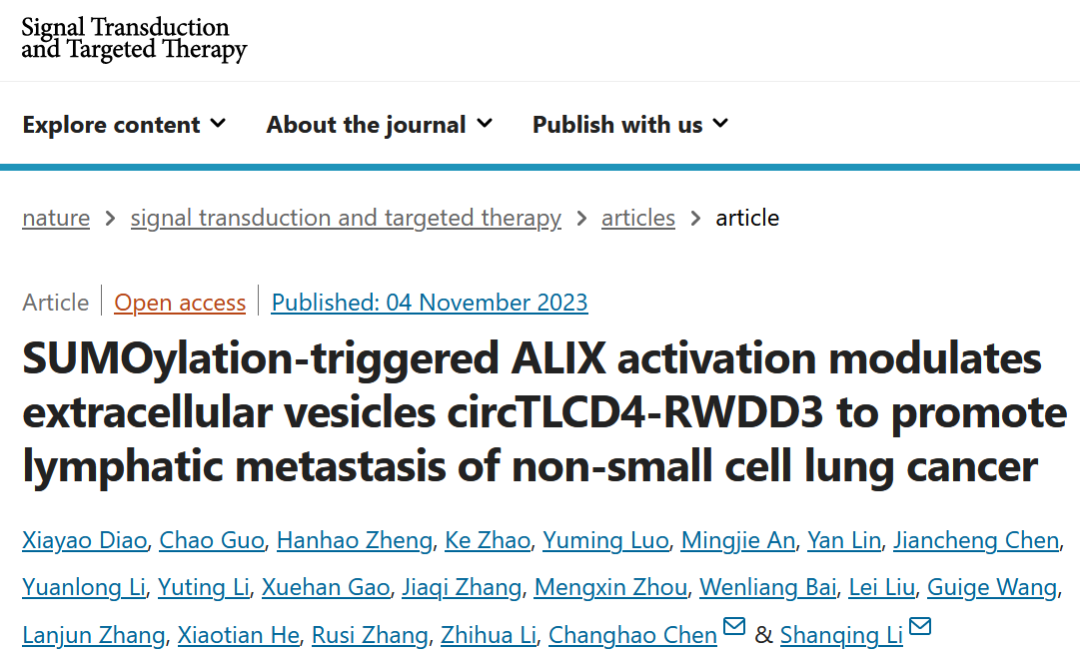Recently, the team led by Li Shanqing, the Director of the Department of Thoracic Surgery at PUMCH, and the team led by Chen Changhao from Sun Yat-sen Memorial Hospital of Sun Yat-sen University, published an article in the international journal “Signal Transduction and Targeted Therapy” (a tier 1 journal, or among the top 5%, as ranked by the Chinese Academy of Sciences, IF: 39.3). The article presented original research on the mechanism of lymphatic metastasis in non-small cell lung cancer (NSCLC). The team revealed the molecular mechanism by which the EV-packaged circTLCD4-RWDD3 induced by SUMOylation promotes lymphatic metastasis in NSCLC. The study suggests that circTLCD4-RWDD3 may serve as a potential therapeutic target for NSCLC. This research holds significant clinical and scientific value and was supported by the Central High Level Hospital Clinical Research Funding.

Lung cancer is the leading cause of cancer-related deaths worldwide and the second most common malignancy globally, with approximately 85% of lung cancer cases being NSCLC. Lymph node (LN) metastasis is one of the predominant metastatic routes of NSCLC and is considered as a leading cause for the unsatisfactory prognosis of patients. Currently, lymphangiogenesis is well-recognized as a crucial process in mediating tumor LN metastasis. Extracellular vesicles (EVs) are membrane‐enclosed nanoparticles that transport molecular cargo, mediate intercellular communication, and promote tumor lymphatic vessel formation. However, regulatory mechanism involving lymphangiogenesis and LN metastasis in NSCLC remains unclear.
The research team performed high-throughput sequencing to identify a novel circular RNA, circTLCD4-RWDD3, which was significantly positively associated with lymphatic metastasis in NSCLC. Moreover, circTLCD4-RWDD3 was notably enriched in NSCLC cell-derived EVs. The results from a multicenter cohort analysis validated the team’s hypothesis, demonstrating that circTLCD4-RWDD3 expression was markedly positively correlated with lymphatic metastasis as well as poor prognosis in NSCLC patients. The in vitro and in vivo experiments were conducted to confirm that circTLCD4-RWDD3 enhanced lymphangiogenesis and further facilitated lymphatic metastasis in NSCLC.
The research team further elucidated the molecular mechanism underlying how circTLCD4-RWDD3 facilitates lymphangiogenesis and lymphatic metastasis in NSCLC. circTLCD4-RWDD3 directly interacted with hnRNPA2B1 and mediated the SUMO2 modification at K108 residue of hnRNPA2B1 by upregulating UBC9. Subsequently, circTLCD4-RWDD3-induced SUMOylated hnRNPA2B1 was recognized by the SUMO interaction motif (SIM) of ALIX and activated ALIX to recruit ESCRT-III, thereby facilitating the sorting of circTLCD4-RWDD3 into NSCLC cell-derived EVs. Moreover, EV-packaged circTLCD4-RWDD3 was internalized by lymphatic endothelial cells to activate the transcription of PROX1, resulting in the lymphangiogenesis and LN metastasis of NSCLC.

▲Schematic illustrating the potential mechanism by which EV-packaged circTLCD4-RWDD3 promotes lymph node metastasis of NSCLC
In the nude mice popliteal LN metastasis model, the delivery of EV-packaged circTLCD4-RWDD3 was impeded by mutating the K108 residue of hnRNPA2B1 or the SIM in ALIX, contributing to inhibit lymphangiogenesis and lymphatic metastasis in NSCLC. These findings suggest EV-packaged circTLCD4-RWDD3 as a potential therapeutic target for lymphatic metastatic NSCLC.
Link to the article: https://www.nature.com/articles/s41392-023-01685-0
Written by Diao Xiayao and Gan Dingzhu
Edited by Gan Dingzhu
Translated by Liu Haiyan
Reviewed by Guo Chao and Wang Yao
